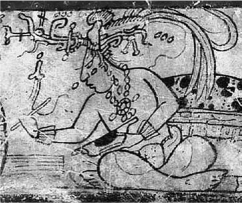Mesoamerican and South American Mythologies: Maya, Aztec, IncaThe Mayan Gods and Heroes |
What was the Maya pantheon? |
There are more than two hundred Mayan gods, and their names vary in different centers. The most famous of the gods was universally worshipped under different names in Mesoamerica. He was Gucumatz for the Quiché Maya, Kukulkan for the Maya of the Yucatán Mexico. He would be the even more famous Feathered Serpent or Quetzalcoatl among the Nahuatl-speaking cultures beginning with the Olmec and the Teotihuacan peoples. Gucumatz was a culture hero as well as a god. With Tepeu, he is the creator in the Popol Vuh. Many Maya believed he came to them from the sea and taught them the arts of civilization before returning to the sea and promising to return one day. He was a “once and future king” like King Arthur. Visitors to Chichen Itza in the Yucatán can watch the shadow of this god, as Kukulkan, the Feathered Serpent, slithering down the steps of the great pyramid there during the spring and fall equinoxes.
There are other important gods named in various Maya traditions. Itzamná is the creator god and usually the sun god. He was once a culture hero who taught the people how to survive and is, therefore, sometimes confused with Kukulkan (Gucumatz) or with the Yucatán creator Kinich Ahau.
Chac, like the Aztec Tlaloc, was a rain and harvest god and a god of thunder. Yumil Kaxob, the Maize god, was dependent on him and was also affected by Ah Puch (Yum Cimil), the god of Death, who was marked with black spots and was associated with skulls and corpses, as was the Hindu goddess Kali. Ix-Chel was one of the great goddesses. Like the Hindu Devi, she is an aspect of a collective of goddesses (Akna). According to some sources, with Itzamná she produced the Bacabs, who hold up the world. Ek Chuah, who is black and who has a scorpion tail, is the god of war and of merchants, suggesting that war and the search for riches are related. Acan is a god of wine and intoxication, the Mayan Dionysos. A strange goddess is Ixtab, who represents suicide and is depicted with a rope around her neck. She takes the souls of suicide victims to paradise. The sacred twins Hunahpú and Xbalanque are of great importance to the Maya and bring to mind the many twins of Indo-European culture.

The maize god was at the highest level of the Mayan pantheon.
